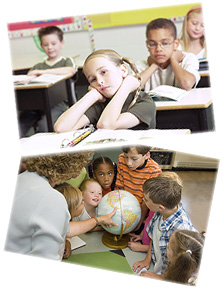What is inclusion and why is it important?
Page 2: How Does Inclusion Differ from Traditional Instruction?
 Although great gains have been made toward creating inclusive schools, according to statistics from the U.S. Department of Education more than one million students still do not have access to the general education curriculum and instruction. Many more are given access to the general education classroom but do not receive the supports they need to actively participate in that instruction. This is the case even though research evidence demonstrates that most students with special learning needs (e.g., students with disabilities, ELs) can succeed in the general education classroom, given the necessary services and supports. In inclusive schools, students not only have access to the general education curriculum but they also receive the supports they need to participate in this instruction and to be successful.
Although great gains have been made toward creating inclusive schools, according to statistics from the U.S. Department of Education more than one million students still do not have access to the general education curriculum and instruction. Many more are given access to the general education classroom but do not receive the supports they need to actively participate in that instruction. This is the case even though research evidence demonstrates that most students with special learning needs (e.g., students with disabilities, ELs) can succeed in the general education classroom, given the necessary services and supports. In inclusive schools, students not only have access to the general education curriculum but they also receive the supports they need to participate in this instruction and to be successful.
Complicating matters is that school personnel sometimes believe they are practicing inclusion even when their school practices more closely resemble the traditional model of instruction. They may have modified their existing practices in an effort to become more inclusive but have not created an overall inclusive environment. The table below offers an overview of both traditional and inclusive schools. By reviewing these items, school personnel can gain a sense of whether their school falls more into the traditional or inclusive category.
| Traditional | Inclusive | |
|
School Climate
|
|
|
|
Curriculum, instruction,
and assessment |
|
|
|
Staff
development |
|
|
|
Support
services |
|
|
|
Parent
involvement |
|
|
|
Community
involvement |
|
|
|
Resources
|
|
|
|
School
self-evaluation |
|
|
|
Comprehensive
education plan |
|
|
| Traditional | Inclusive | |
|
School Climate
|
|
|
|
Curriculum, instruction,
and assessment |
|
|
|
Staff
development |
|
|
|
Support
services |
|
|
|
Parent
involvement |
|
|
|
Community
involvement |
|
|
|
Resources
|
|
|
|
School
self-evaluation |
|
|
|
Comprehensive
education plan |
|
|
Adapted from Lipsky and Gartner (2008).
Elaine Mulligan is the former assistant director of NIUSI-LeadScape, a project funded by the U.S. Department of Education’s Office of Special Education Programs, which supports principals working to create inclusive school environments. Listen as she explains why inclusive schools are better than traditional ones and highlights some of the characteristics typical of an inclusive school (time: 3:03).

Transcript: Elaine Mulligan
I think inclusive schools are better than traditional schools on two levels. On a social-justice level, inclusive schools are the best way of insuring that all students have equitable access to the school’s facilities, curriculum, and resources. The other level on which inclusive schools are better than traditional schools is an outcomes-oriented perspective. Research has shown that students who have been identified as having disabilities achieve higher levels of academic success when they’re taught in inclusive settings. Also, students who haven’t been identified as having disabilities but who might struggle in some areas also benefit from the additional support in differentiated teaching strategies used in inclusive settings.
An inclusive school is one in which you create a school culture of all students having full access to everything, and that’s not just students with disabilities. It’s students who are English language learners. It’s students who are in those subgroups that are not performing. It’s making sure that all students are fully ratified participants of the school. So what that looks like in a school is collaboration at all levels. There is shared governance of the school, including family and community participation in the decision-making process. That is something that our schools have really struggled with and that doesn’t come right away.
On the teacher level, it’s shared planning time for teachers to design instruction with multiple access points and multiple methods of demonstrating mastery. That’s not co-teaching, where you have a special educator come in for thirty minutes and help her little four kids and go away. This is shared responsibility for the full class, and that requires a lot of planning that is hard to do at first. It becomes second nature once you’ve been doing it a while, but it takes a while. And then in the classroom, what it looks like is authentic content material being taught in interactive student-centered ways so that all the students are engaged in constructing knowledge. It doesn’t look like a regimented, scripted curriculum.
In a classroom the support staff, from the special educators to related service providers, Title One staff, are all integrated into daily classroom routines rather than pulling students out of class for services.
And then an inclusive school is culturally responsive. So the activities, materials, community partnerships, clubs, are based in the students’ and families’ funds of knowledge. So it doesn’t look like one particular thing; it looks like your population. So everybody is involved. If you have an increasing Hispanic population, you’re going to have different kinds of readings and interactions and activities than if you have a primarily African American population, or if you have a completely mixed one, then you have a fun variety of things going on, but just multiple access points that are related to your kids and not to the curriculum that’s handed down to you.
After her meeting with Principal Sherman, Ms. Lawrence evaluates Central Middle School to determine its level of inclusiveness. The movie below describes what she found (time: 1:05).
Transcript: Ms. Lawrence Evaluates Central Middle School
Principal Lawrence: My meeting with Principal Sherman gave me a lot to think about. I began to look at my own school through new eyes. I observed in the hallways and cafeteria, looked through student records and IEPs, and talked to coaches and club sponsors. Unfortunately, what I saw wasn’t an inclusive school. What I saw was a lot of exclusion. Now that I knew what to look for, I realized that our students with disabilities didn’t really have full access to the general ed curriculum. Far fewer students were included in general education classes than I thought, and even fewer participated in clubs and sports. That was the same for kids from diverse and low-income backgrounds. Although I did observe good use of assistive technology, it was only in the special ed classrooms. As I realized how much time our kids with disabilities were spending outside general ed, I began to understand why Tim was unhappy here and why attending Monet High was a more successful experience for him. It’s clear that we need to make a change.
For Your Information
- Far from being just another fad or add-on program or practice, inclusion is a fundamental shift in how schools approach the instruction of all students.
- It is important to remember that special education is a service, not a place. In other words, a student with a disability does not automatically get placed in a special education classroom. Instead, the IEP team determines what services the student needs based on his or her current level of performance and then decides where those services should be provided.
x
individualized education program (IEP) team
glossary
- Inclusion does not necessarily mean that every special education student spends every minute of every day in a general education setting. What it does mean is that each special education student is guaranteed a free appropriate public education (FAPE) in the least-restrictive environment (LRE). Depending on a student’s needs, services may be provided in a number of settings by a number of individuals.